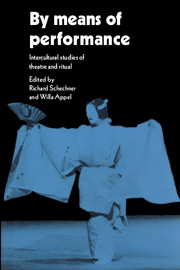Book contents
- Frontmatter
- Contents
- List of figures
- Notes on contributors
- Concerning Victor Turner
- Introduction
- 1 Are there universals of performance in myth, ritual, and drama?
- 2 Magnitudes of performance
- 3 Liminality: a synthesis of subjective and objective experience
- 4 The Yaqui deer dance at Pascua Pueblo, Arizona
- 5 A Yaqui point of view: on Yaqui ceremonies and anthropologists
- 6 Performance of precepts/precepts of performance: Hasidic celebrations of Purim in Brooklyn
- 7 The significance of performance for its audience: an analysis of three Sri Lankan rituals
- 8 What does it mean to “become the character”: power, presence, and transcendence in Asian in-body disciplines of practice
- 9 Korean shamans: role playing through trance possession
- 10 The practice of noh theatre
- 11 The profanation of the sacred in circus clown performances
- 12 Ethnographic notes on sacred and profane performance
- 13 The spatial sense of the sacred in Spanish America and the American South and its tie with performance
- 14 Space and context
- 15 The transformation of consciousness in ritual performances: some thoughts and questions
- 16 Universals of performance; or amortizing play
- Appendix
- Bibliography
- Index
4 - The Yaqui deer dance at Pascua Pueblo, Arizona
Published online by Cambridge University Press: 05 June 2012
- Frontmatter
- Contents
- List of figures
- Notes on contributors
- Concerning Victor Turner
- Introduction
- 1 Are there universals of performance in myth, ritual, and drama?
- 2 Magnitudes of performance
- 3 Liminality: a synthesis of subjective and objective experience
- 4 The Yaqui deer dance at Pascua Pueblo, Arizona
- 5 A Yaqui point of view: on Yaqui ceremonies and anthropologists
- 6 Performance of precepts/precepts of performance: Hasidic celebrations of Purim in Brooklyn
- 7 The significance of performance for its audience: an analysis of three Sri Lankan rituals
- 8 What does it mean to “become the character”: power, presence, and transcendence in Asian in-body disciplines of practice
- 9 Korean shamans: role playing through trance possession
- 10 The practice of noh theatre
- 11 The profanation of the sacred in circus clown performances
- 12 Ethnographic notes on sacred and profane performance
- 13 The spatial sense of the sacred in Spanish America and the American South and its tie with performance
- 14 Space and context
- 15 The transformation of consciousness in ritual performances: some thoughts and questions
- 16 Universals of performance; or amortizing play
- Appendix
- Bibliography
- Index
Summary
20 November 1981: the day of Anselmo Valencia's talk
The talk took place in the ramada, a plain brick shelter open to the south (see figure 4.1). The members of the Wenner-Gren conference sat on one side, while Anselmo Valencia stood on the other, on the dancing ground of the deer – sacred ground, as he explained to us. To his left lay a blanket, on which we saw the deer dance regalia set out: the deer's head, rasps, and water drum. At a board rising in a nearly 90° angle at the sacred side of the entrance were set a flat drum and a flute.
Valencia began by introducing the dancers – deer and pascola. Then he turned to his listeners and reminded them that they were Anglos, anthropologists, and that he had had a lot of trouble from anthropologists. Their incessant questions made it very difficult for the Yaquis. There must be no photographs, there had been too much of that sort of thing. (For that reason, I could not bring out my notebook and take down everything he said, contenting myself with writing down afterwards what Victor Turner and I remembered.)
Valencia strode up and down a little, getting indignant. “What is this word, ‘savage’?” he asked – a word that Anglos and Mexicans used about the Yaquis. He asked various people in his audience what the word meant. Victor Turner replied that he never used the word but it meant the people of the wilds, the woods, the heath.
- Type
- Chapter
- Information
- By Means of PerformanceIntercultural Studies of Theatre and Ritual, pp. 82 - 95Publisher: Cambridge University PressPrint publication year: 1990
- 2
- Cited by



